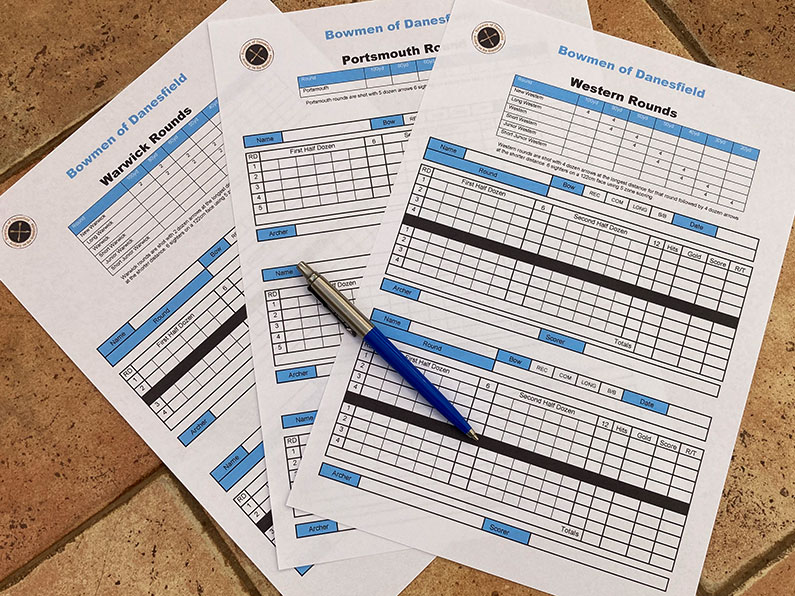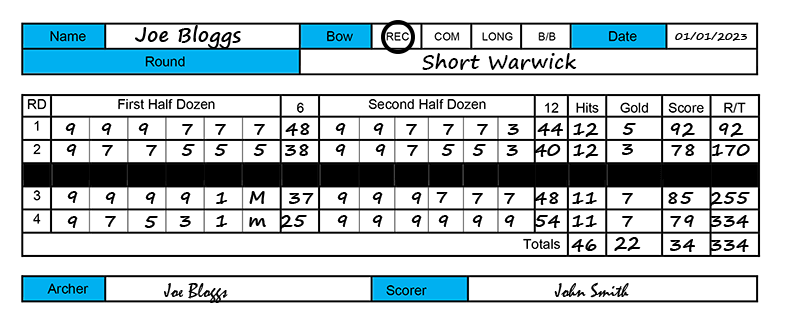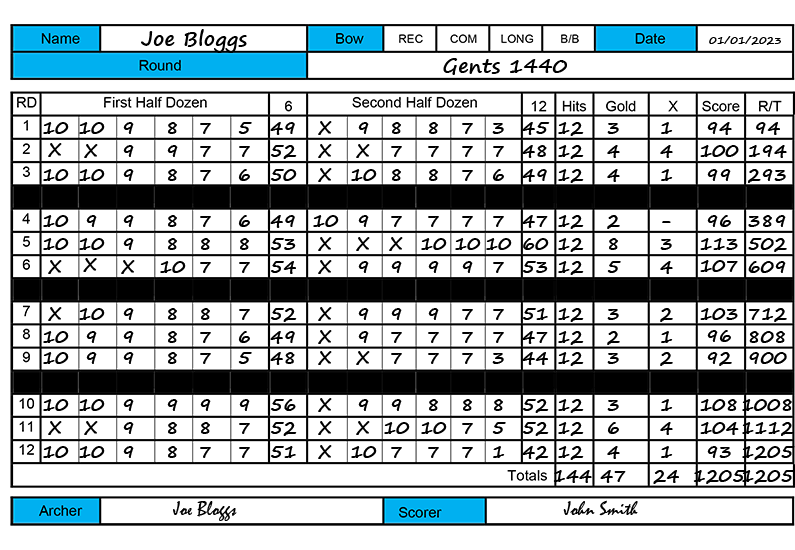The Archery Scoresheet
Why Keep Score?
Keeping score in archery or any other sport is a way to track your personal progress and improvement over time. It can also help identify areas where you need to focus your practice and provide motivation to continue to work on your skills. While competition with others can be a fun aspect of sports, the most important competition is often with yourself, striving to improve and achieve your personal best.
Scoring yourself can be a helpful way to monitor that progress and stay motivated to keep practising and perfecting your skills.
Scoring is based on the round being shot, and there are over 200 different rounds to choose from. Primarily divided into Imperial and metric rounds.
Scoring in Archery
Scoring in archery is straightforward and involves counting the value of each arrow landing in each scoring zone of the target and recording the scores on a score sheet. Cross-scoring involves two or more archers verifying each other’s scores to ensure accuracy and prevent cheating.
The accepted way to call out the scores is to read them from high to low, for example, “nine, nine, six”. They are always called out in blocks of three with individual arrow scores, i.e. 997, never 2 – 9s and 7, as that can be misinterpreted.
Touching the arrows during scoring is not allowed, but if you do, you will score the lower value.
If the archer is scoring themselves, this should be indicated by not filling in the scorer section unless it has been checked and verified. It is always recommended to have the scores double-checked by someone, such as the target captain, to ensure accuracy.
Submitting Your Scores
The club maintains a record of all scores submitted, and they should be sent to records@bowmenofdanesfield.co.uk
These provide an essential resource for scores, handicaps, classifications and club records. They enable the club to award various badges and trophies throughout the year.
In addition, they are used when the club is participating and are submitted on your behalf in virtual competitions with other clubs and organisations, such as SCCA and The Virtual Archery League.
The club started in 1998 and has maintained our score records since the 3rd of April 2011, when Roland Dunkley submitted a score of 373 for a Western round. He is still a member.
Wherever you shoot, at the club, as a guest at another club or in a competition, it is beneficial to submit your scores.
You can check your Handicaps and Classifications and take a look at the Club Records. In addition, if you wish, you can look at your entire score history.
Your scores should be submitted to records@bowmenofdanesfield.co.uk
Five and Ten Zone Scoring

The archery target is typically divided into five coloured scoring zones, each with a different point value. Each zone is divided into two further areas, and the gold central area has a smaller section known as the X ring.
Most metric rounds use a 10-zone scoring system, where the bullseye is worth ten points, and each consecutive ring is worth one less point.
Imperial rounds mostly use a 5-zone system, where the centre ring is worth 9 points, the next two rings are worth 7 points, and the outer two rings are worth 1 point.
Ten Zone Scoring 10, 9, 8, 7, 6, 5, 4, 3, 2, 1. with the centre circle in some competitions is scored as an X and misses as M.
Five Zone Scoring 9, 7, 5, 3, 1 and misses as M.
Recording your Scores
Paper or electronic scoring
Both paper and electronic scoring have their advantages and disadvantages.
Paper score sheets have been the primary medium for recording scores in archery and are still largely used in competitions, sometimes alongside an electronic system. However, if there is a dispute, the paper record is used as the confirmation option.
Electronic systems, because of the advent of the smartphone, where many different apps recording scores have been introduced, have become very common in club archery. However, they provide a challenge for the club’s record officer, where it is more difficult to confirm the accuracy of the submitted scores.
Ideally, the electronic score entered into the app is signed off by a second archer, and that entire record, including the signature of both the archer and scorer, is submitted.
A list of archery scoring apps is provided after information on filling in a paper scoresheet.
The Archery Scoresheet at the Bowmen of Danesfield
Imperial Score Sheet Example
In this example, a Short Warwick round is shot over two distances separated by the black band.
Imperial Rounds
Imperial rounds are a traditional British archery competition format shot at distances measured in yards.
The scoring system, which uses a 5-zone target, dates back almost 200 years and is attributed to King George IV.
The five zones, in order of decreasing point value, are gold (9 points), red (7 points), blue (5 points), black (3 points), and white (1 point).
Any arrows that do not hit the target or land outside of the scoring zones are recorded as misses (M) and score zero.
Imperial Indoor Rounds
Ten Zone Scoring is used indoors, except that the X-ring is not recorded.
Metric Score Sheet Example
In this example, a Gents 1440 round is shot over four distances separated by the black band.
Metric Rounds
Metric rounds are an international format recognized by World Archery, shot at distances measured in meters.
They use a “10-zone” scoring system, similar to indoor rounds, where each colour is divided into an inner and outer zone. For example, the inner blue scores 6 points and the outer blue scores 5 points. As with Imperial rounds, misses are recorded as “M” and score zero. The X-ring is also recorded in the event of a draw.
Filling in the Scoresheet
IMPORTANT- To ensure that your scores are processed accurately and your handicaps, classifications, and club records are up to date, please make sure to fill out the archery scoresheet completely and legibly. Incomplete or inaccurate score sheets may not be accepted and may not count towards your classification or handicap.
Whether using paper scoresheets or smartphone apps, the following guidelines should apply.
Record your full name and the date shot, along with the Bow Type, and record the round you are shooting.
In most circumstances, you will have six sighters to adjust your aim or sights before the scoring starts.
The score sheet in archery is filled in horizontally, with each half dozen recorded and then totalled. The first six arrows are totalled, and the second six arrows are totalled. and finally, the number of hits for that dozen is recorded. Likewise, the number of golds*, and then the score for that first dozen. and R/T stands for Running Total.
Indoors you shoot three arrows per end, and outdoors six arrows per end.
In outdoor Metric rounds, you also record the X ring as an X instead of a ten. Imperial rounds do not record the X-ring.
A miss is entered as an M.
* The Golds recorded depend on whether it is five-zone or ten-zone scoring. In the five-zone, it is the number of 9s, and in the ten-zone, the number of 10s which includes the X-ring.
SmartPhone Apps
Many archery score-recording apps are available, offering a whole range of features.
Ultimately, the best archery scoring app for you will depend on your individual needs and preferences. You can try out different apps and compare their features to find the best one for you. Some are free others are on a subscription basis.
From a club standpoint, they should be capable of accurately recording the scores and provide a facility for archer and scorer signatures and then the facility of being able to submit that to records@bowmanofdanesfield.co.uk
Which Apps
With the abundance of apps available, it comes down to personal preference but worth checking with other archers as to which they find works for them. Remember to choose one that Supports Archery GB Rounds, Handicaps and classifications
The Apps below are used by some of our members, there may be others.
Expert Archer – FREE – is about as good as it gets. The example is a score submission from Expert Archer.
Archery Scoresheets – FREE – Is another good alternative
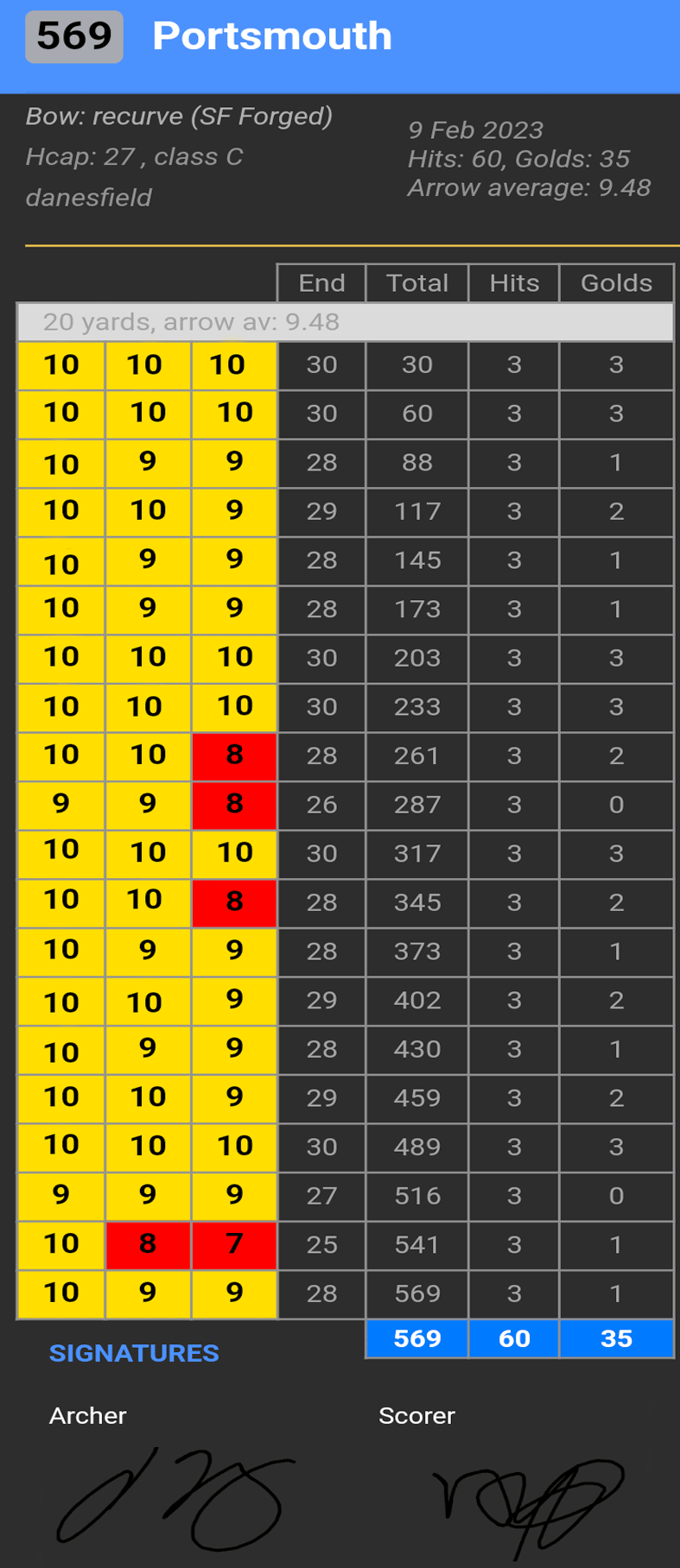
The X ring
In the Metric round, there is an inner gold ring which scores 10 points, and inside that, there is a smaller inner ten or X ring.
When shooting outdoors, any arrows that land in the inner ten ring are recorded on the scorecard as an X and score 10. This is the same for both recurve and compound archers, and it differs from the scoring system used in indoor rounds, where there are no Xs, only 10s and 9s.
The inner ten or X ring is the highest possible score that can be achieved on the target face and is used if there is a draw; the archer with the highest number of xs wins.
Sighters or Practice
In most Imperial shoots, you are allowed to shoot six arrows, known as sighters, to adjust your aim or sights before the scoring section of the round starts.
In Metric rounds, whilst the club usually allows six arrow sighters before scoring in World Archery run competitions, you are allowed up to 45 minutes of practice.
Bouncers
Typically, bouncer arrows are not scored and do not count towards a shooter’s score. Instead, they are usually retrieved after all the other archers have finished the end and then reshot.
In competition, it is usually at the control and discretion of the judge to allow the arrow to be reshot, this might depend on the type of round for instance, in a metric round where the arrow positions have been marked, the judge will determine where the bouncer hit the face.
Hangers
if an arrow hits the target but does not penetrate fully and hangs down, it is often referred to as a “hanger.” In this case, the archer should notify the judge, who will call a “Fast” to temporarily stop shooting and push the hanger into the target to avoid obstructing of subsequent arrows.
It still scores based on the mark it made on the target face.
Line Cutters
The rules for determining the score of an arrow in archery can be a bit complex, and it’s important to understand them so that everyone can agree on the score. The line-cutting rule ensures that an arrow is always scored based on its closest proximity to the higher value zone rather than being arbitrarily split between two zones. It’s always good to consult a judge if there is any disagreement or confusion, as they will have the final say on the scoring.
A Robin Hood
In archery, a “Robin Hood” occurs when an arrow is shot and hits the back end or nock of another arrow already in the target, splitting or embedding itself in the first arrow.
When this happens, the Robin Hooded arrow is scored the same as the arrow in which it is embedded. In other words, if the arrow that was hit was a nine or a ten, the Robin Hooded arrow is also scored as a nine or a ten. This is to acknowledge the skill and precision required to hit such a small target area and prevent the archer from being penalized for the second arrow being “out of play” after hitting the first arrow.
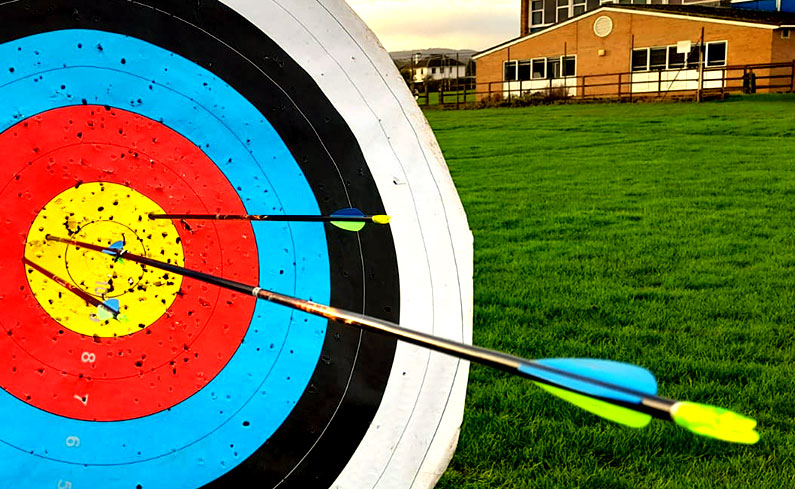
Competing
Timing
Not directly related to scoring but should be borne in mind when you are shooting are the rules relating to timing.
In competition, you have 10 seconds to get to the line after two whistles are sounded. You will then hear one whistle and have 120 seconds to shoot your three arrows indoors or 240 seconds in outdoor competitions.
With 30 seconds to go, you will see a yellow warning light and a red light to stop shooting and retire from the line.
Correcting Mistakes
If a mistake is made, the scorer must not change the individual arrow scores – only a judge can make and sign a correction.
However, the scorer can change any errors in the additional numbers.
Metric Rounds
In competition, arrow positions should be marked in thin black/blue ink with a > pointing at the arrow hole; on the target after scoring but before removing the arrows.
In the event of a bouncer, the judge will determine where that arrow hit the target for scoring purposes rather than shooting a further arrow.
It is the responsibility of all archers on the target to ensure that arrow holes are marked in metric rounds. This ensures that the correct score is recorded for each arrow and helps to avoid confusion or disputes later on.
One of the archers shooting on a target is usually appointed to be the marker, whilst another records the scores.
Scoring in Olympic Archery
Olympic archery only uses a recurve bow and is scored using the World Archery-approved 122cm, 10-zone target face at a distance of 70 metres.
Archers shoot 72 arrows in the qualification round, and their scores are added to determine their rank for the elimination round.
In the elimination round, archers compete head-to-head, known as Matchplay, and the winner is determined by who scores the most points in a set number of arrows. The scoring system remains the same as in the qualification round.
In the Matchplay phase, archers shoot five sets, each of three arrows for the individual event, four arrows in the mixed team event and the team event six arrows per set. The winner from each Matchplay goes forward to the next round.
The Official Club Scoresheets
Submitting your Scores

